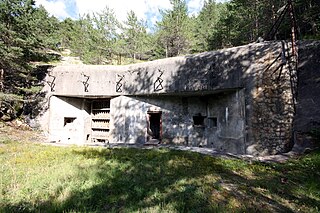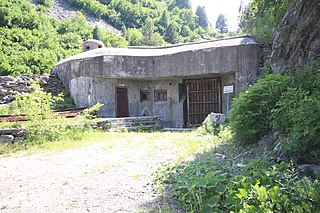
Ouvrage Sapey is a work of the Maginot Line's Alpine extension, the Alpine Line, also known as the Little Maginot Line. The ouvrage consists of one entry block, three artillery blocks and one observation block two kilometers west of Modane. The ouvrage was built beneath the older Fort du Sapey. The new work cost 12.8 million francs.

Ouvrage Saint-Antoine is a work of the Maginot Line's Alpine extension, the Alpine Line. The ouvrage consists of one entry block, one infantry block and one artillery block overlooking Modane on the way to the Col du Mont Cenis. Ouvrage Saint-Gobain is just to the north, across the mountain valley. Saint-Antoine overlooks the approaches to the Fréjus Rail Tunnel and was part of an ensemble of forts, including Saint-Gobain, Ouvrage Sapey and Fort du Replaton that guarded the French end of the tunnel and the descent from the Mont Cenis pass.

Ouvrage Le Lavoir Is a work of the Maginot Line's Alpine extension, the Alpine Line, also called the Little Maginot Line. The ouvrage consists of two entry blocks, one infantry block, three artillery blocks and one observation block 6 kilometres (3.7 mi) south of Modane, France, guarding the Col de Fréjus. The surface barracks at Le Lavoir were connected to Charmaix by an aerial tram.

Ouvrage Pas du Roc is a work of the Maginot Line's Alpine extension, the Alpine Line. The ouvrage consists of one entry blocks, one infantry block, two artillery blocks and one observation block 6 kilometres (3.7 mi) south of Modane and 1.6 kilometres (0.99 mi) east of Ouvrage Le Lavoir in the vicinity of the Col de Fréjus. The position was incomplete at the outbreak of war in 1940.

Ouvrage Col du Granon is a lesser work of the Maginot Line's Alpine extension, the Alpine Line. The ouvrage consists of one entry block, one infantry block and one observation block covering the Col du Granon as part of the defenses of Briançon and Grenoble. The ouvrage lies at an altitude of 2,329 metres (7,641 ft).
Ouvrage Roche-la-Croix is a work of the Maginot Line's Alpine extension, the Alpine Line, also known as the Little Maginot Line. The ouvrage consists of one entry block, two infantry blocks, one artillery block and two observation blocks in the vicinity of the Col de Larche. An aerial tram was provided for better access. The position is located at the top of a sheer escarpment that dominates Meyronnes and the valley of the Ubayette.

Ouvrage Saint Ours Haut is a work of the Maginot Line's Alpine extension, the Alpine Line, also known as the Little Maginot Line. The ouvrage consists of one infantry block, one artillery block, two observation blocks and one combination block in the vicinity of the Col de Larche. It is located on the territory of the commune of Meyronnes. Construction began in March 1931, at a cost of 15.1 million francs.
Ouvrage Saint Ours Nord-est is a lesser work of the Maginot Line's Alpine extension, the Alpine Line. The ouvrage consists of two infantry blocks. The associated underground support galleries are arranged with a short gallery connecting Blocks 1 and 2, with parallel stubs at Block 2. While it is listed in some sources as an ouvrage owing to its construction by CORF, it is more like an infantry abri or shelter.

Ouvrage Restefond is a work of the Maginot Line's Alpine extension, the Alpine Line. The ouvrage consists of one artillery block and three observation blocks at the summit of the Col de la Bonette. The entry block and an artillery block were not completed, and a further block was never built. At 2,733 metres (8,967 ft), Restefond is the highest Maginot ouvrage.

Ouvrage Col de Restefond is a lesser work of the Maginot Line's Alpine extension, the Alpine Line. The ouvrage consists of three infantry blocks. It is located directly adjacent to the Col de Restefond road at an altitude of 2,680 metres (8,790 ft). Construction work was completed in 1934, but the ouvrage was not armed until 1938.
Ouvrage Col du Caire Gros is a lesser work of the Maginot Line's Alpine extension, the Alpine Line. The ouvrage consists of two entry blocks at an altitude of 2,048 metres (6,719 ft). Additional blocks were planned but not built.
Ouvrage Col du Fort is a lesser work of the Maginot Line's Alpine extension, the Alpine Line. The ouvrage consists of one infantry block and one observation block at an elevation of 1,717 metres (5,633 ft). An additional block was planned but not built.
Ouvrage Gordolon is a work of the Maginot Line's Alpine extension, the Alpine Line, also known as the Little Maginot Line. The ouvrage consists of one and two infantry blocks at an altitude of 728 metres (2,388 ft). Gordolon was built by Borie contractors at a cost of 21.4 million francs. Work started in November 1931 and was completed in April 1934.

Ouvrage Flaut is a work of the Maginot Line's Alpine extension, the Alpine Line, also called the Little Maginot Line. The ouvrage consists of one entry block, one infantry block and one artillery block at an altitude of 771 metres (2,530 ft). The position was intended, acting with Ouvrage Gordolon, to stop an approach by Italian forces from the north towards Nice through the Vésibie Valley.

Ouvrage Plan Caval is a lesser work of the Maginot Line's Alpine extension, the Alpine Line, also known as the Little Maginot Line. The ouvrage consists of two infantry blocks and one observation block facing Italy. The ouvrage is located on the heights of L'Authion, surrounded by older fortifications. Three additional blocks were planned to make it a gros ouvrage but were not built. Cost for the full ensemble was estimated at 23 million francs.
Ouvrage La Béole is a lesser work of the Maginot Line's Alpine extension, the Alpine Line. The ouvrage consists of one entry block and two observation blocks at an altitude of 1,548 metres (5,079 ft). The ouvrage consists of two entry blocks and one observation block facing Italy. The ouvrage was manned by 94 soldiers in 1940, under the command of Sub-Lieutenant Caillard. Additional blocks were planned but not built. The ouvrage was never provided with electricity. Three more blocks were planned but not built.
Ouvrage Col de Brouis is a work of the Maginot Line's Alpine extension, the Alpine Line, also known as the Little Maginot Line. The ouvrage consists of one entry block and two artillery blocks facing Italy at an altitude of 871 metres (2,858 ft). The ouvrage is located about one kilometer north of Monte Grosso. It was placed to control the Col de Brouis and the D 2204 road between the Breil and Sospel.
Ouvrage Monte Grosso is a work of the Maginot Line's Alpine extension, the Alpine Line, also known as the Little Maginot Line. The ouvrage consists of one entry block, four artillery blocks and two observation blocks facing Italy. It was the largest ouvrage in the Alps It is part of the fortifications surrounding Sospel, which protect the approaches to Nice from the north.
Ouvrage Champ de Tir, also known as Champ de Tir de l'Agaisen is a lesser work of the Maginot Line's Alpine extension, the Alpine Line. It is located at an altitude of 672 metres (2,205 ft), less than 1 kilometer to the northwest of Ouvrage l'Agaisen. The ouvrage consists of two entry blocks and one infantry block, sited to control the valley of the Nieya and to observe for l'Agaisen.

Ouvrage Saint-Roch is a work of the Maginot Line's Alpine extension, the Alpine Line, also known as the Little Maginot Line. Small for a gros ouvrages, the ouvrage consists of one entry block, one artillery block and two observation blocks overlooking Sospel at an altitude of 426 metres (1,398 ft). The position is located just to the southwest of Sospel, its entrance block in a narrow valley and the artillery block on the other side of the ridge overlooking Sospel. The ouvrage is laid out along a single line, with the entry block to the rear, immediately followed by the usine, with barracks farther along and Blocks 2 and 3 at intervals. The position's main armament is concentrated in Block 4, a massive blockhouse designed to protect against rockfalls from higher up the mountain.












